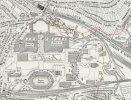Mcr Warrior
Veteran Member
- Joined
- 8 Jan 2009
- Messages
- 14,700
With a nod towards today's FA Cup Final at Wembley, was having a look at a mid 1930's era OS map of the immediate area, which, as well as Wembley Stadium (Wembley Exhibition) station, shows various other presumably non-passenger lines to the East / North East side of the stadium.

(Pic of 1930's OS map of Wembley Stadium area).
What premises were served by these lines, and when were the lines removed?
Would imagine there's nothing original much there now and everything's long since been built over.
Anyone able to add to the discussion...
P.S. Believe the station lasted until the late 1960's.

(Pic of 1930's OS map of Wembley Stadium area).
What premises were served by these lines, and when were the lines removed?
Would imagine there's nothing original much there now and everything's long since been built over.
Anyone able to add to the discussion...
P.S. Believe the station lasted until the late 1960's.


